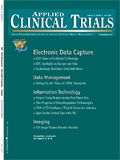eCTD Guidance Takes Center Stage
Applied Clinical Trials
Five-module architecture organizes massive amounts of information included in a marketing submission.
Is your organization planning for the transition to electronic submissions using the eCTD specification? In September 2006, the FDA announced the withdrawal of the guidance for electronic submission of the following three submission types:
- Providing Submissions in Electronic Format—NDAs (eNDAs)
- Providing Regulatory Submissions in Electronic Format—ANDAs (eANDAs)
- Providing Regulatory Submissions in Electronic Format: Annual Reports for NDAs and ANDAs (2003)1
Currently, applicants have three choices when submitting a marketing application electronically: Use the eNDA/eANDA format, use the eCTD format, or use what is called a hybrid submission (the older eNDA format with the table of contents organized using the newer CTD headings).2
The variety of choices can be confusing and frustrating for the life sciences industry, which is not receiving consistent recommendations about how to electronically submit marketing applications. It is also confusing and frustrating for the agency review staff and has forced the agency to maintain expensive, duplicative processes and systems for receiving and archiving these various application types.2
With the recent guidance withdrawal, FDA has simplified the guidance maze by exclusively condoning the use of the guidance: Providing Regulatory Submissions in Electronic Format—Human Pharmaceutical Product Applications and Related Submissions Using the eCTD Specifications. So, now the eCTD specification has taken center stage at both the FDA and within the industry.

(PHOTOGRAPHY: COMSTOCK ILLUSTRATION: JENNIFER FOLEY )
eCTD Capabilities
The eCTD guidance sets itself apart technically from the eNDA and eANDA guidance in that the submission's table of contents is no longer submitted as a PDF file. With the new eCTD standard, the FDA and the international life sciences standards entity, the ICH (International Conference on Harmonization), introduce a major change to the fundamental structure of the submission by using an XML file as the underlying backbone, which in turn defines and contains the table of contents.
The basic architecture that the eCTD standardizes is a five-module approach adapted from the Common Technical Document (CTD) originally developed by the ICH. This five-module architecture is used to organize the vast amount of information that is included within a submission.

Breakdown of the Five Modules
Within the sections, the eCTD specification also limits the file formats an applicant can use within an electronic submission. Among those supported are PDF files for reports and forms; SAS XPORT (version 5) transport files for datasets; ASCII text files for SAS program files and NONMEM control files; MS Word (RTF) for draft labeling; as well as growing support for the CDISC SDTM data standard.
XML benefits
Capitalizing on the acceptance and adoption of XML technology, the eCTD specification allows reviewers and submitters to easily browse submissions using a common Internet browser. Leveraging the power of the XML standard as it is applied to the eCTD specification, dossiers can be viewed comprehensively with each amendment layered against the original submission, rendering the life cycle and documentation of a product as it changes over time in an easily viewable and understandable format.
Specifically, using the XML file allows an applicant to update the application's table of contents automatically as new amendments are filed. This enables sponsors and reviewers access to a real-time, up-to-date, cumulative table of contents and immediate access to all files included in an application, regardless of when they were included or in what submission they are located. This type of flexibility and efficiency has never been previously possible at either the applicant or reviewer levels. Applying the eCTD specification to the XML standard also provides for reusability of the applicant's submission documents for different regional markets.
Another advantage is that through the creative use of the XML metadata, the table of contents can be displayed in various ways, allowing for discipline-specific views of an application (e.g., chemistry vs clinical), cumulative life cycle views showing all documents and their current state, submission specific views displaying only the delta between submissions, module specific views, etc.—all further promoting review and assembly efficiency. This is especially important for agency review staff and industry's time to market.
How to leverage eCTD
Organizations looking to leverage the advantages provided by moving to electronic submissions will face many challenges, as the undertaking will require a significant amount of resources and dedication to accomplish. After alerting management to the withdrawal notice and subsequently obtaining their buy-in, a business and technical strategy should be developed during the initial planning phases.
Participants in the project will need to acquire familiarity with the FDA guidance and be well-versed in the supporting guidelines. Business standards will need to be developed to support the paradigm shift from paper to electronic, which will in turn lead to modifications of business process and, at the lowest levels, department and area standard operating procedures. Key to the strategy will be integrating the numerous contributor and author areas so that they have the appropriate access and control over their deliverables. A communications plan that is established and maintained throughout the process can help the numerous groups and areas involved to voice issues and obtain answers to questions as they arise.
The technical strategy will also play a major roll in the transition to electronic submissions, as there will be many layers of technology with many tools involved in order to publish a completed submission. The team will have to determine what technology will be necessary and what can be leveraged within the existing environment. Technology that is currently unavailable within the organization will have to be analyzed with respect to the organization's information technology department to determine buy vs build.
Is building the tool internally an option or does the organization's IT budget demand the integration of an existing product? When purchasing a tool, have the integration and on-going maintenance costs been considered? Is the tool going to be easily accessible to everyone involved with the eCTD submissions? Are there technical considerations regarding site size? For example, is it a small, single site organization or a large, multiregional one? How will any technology changes proposed affect the organization or its efficiency?
These questions must be addressed while trying to manage and maximize your organization's current resources. Remember—once eCTD, always eCTD.
Conclusion
The FDA is recommending that sponsors who want to submit applications electronically use the most efficient and internationally agreed upon formats recommended in their most recent guidance. This will certainly lead to changes within organizations adopting the new standard and will also enable dossier control, which was never previously possible.
References
1. Docket Nos. 1999D-0054, 2001D-0475, and 2003D-0364] (formerly Docket Nos. 99D-0054, 01D-0475, and 03D-0364, respectively).
2. Excerpt taken from the Federal Register/Vol. 71, No. 189/Friday, 29 September 2006/Notices written by Jeffrey Shuren, Assistant Commissioner for Policy. [FR Doc. E6-15966 Filed 9-28-06; 8:45 A.M.].
Jay Johnson is a senior business analyst with TAKE Solutions, 600 College Road East, Suite 3500 Princeton, NJ 08540, (919) 861-2975, email: Jay.Johnson@TAKESolutions.com

FDA Fast Tracks Johnson & Johnson’s Nipocalimab for Fetal Neonatal Alloimmune Thrombocytopenia
March 27th 2024Johnson & Johnson is moving forward with a pair of Phase III trials of nipocalimab to reduce the risk of fetal neonatal alloimmune thrombocytopenia in alloimmunized pregnant patients.